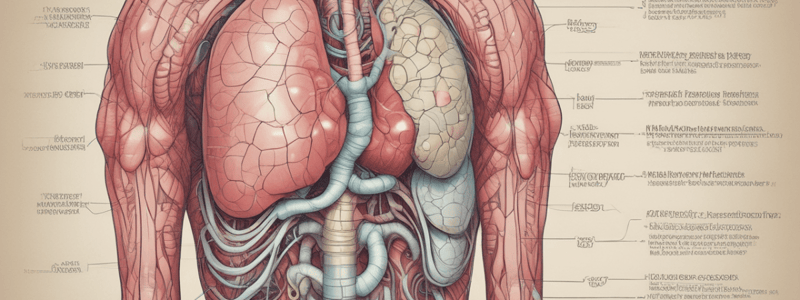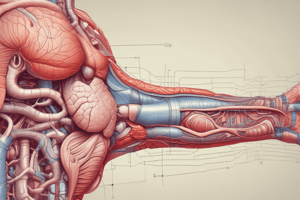Podcast
Questions and Answers
Where does the absorption of nutrients primarily occur in the digestive system?
Where does the absorption of nutrients primarily occur in the digestive system?
- Stomach
- Large intestine
- Small intestine (correct)
- Mouth
What is the role of intestinal villi in the digestive system?
What is the role of intestinal villi in the digestive system?
- To excrete waste products
- To increase the surface area for nutrient absorption (correct)
- To move food through the digestive system
- To mix food with gastric juices
What is the process of muscular contractions that helps move food through the digestive system?
What is the process of muscular contractions that helps move food through the digestive system?
- Nutrient absorption
- Gastric digestion
- Villi formation
- Peristalsis (correct)
What is the main function of the colon in the digestive system?
What is the main function of the colon in the digestive system?
What is the name of the hair-like structures that cover the surface of intestinal villi?
What is the name of the hair-like structures that cover the surface of intestinal villi?
Where does gastric digestion begin in the digestive system?
Where does gastric digestion begin in the digestive system?
What is the main function of the stomach in the digestive process?
What is the main function of the stomach in the digestive process?
What is the process by which food is propelled through the digestive tract?
What is the process by which food is propelled through the digestive tract?
Where does the absorption of water and electrolytes from the waste products of digestion occur?
Where does the absorption of water and electrolytes from the waste products of digestion occur?
What is the role of microbes in the colon?
What is the role of microbes in the colon?
What is the final destination of waste products in the digestive system?
What is the final destination of waste products in the digestive system?
What is the primary function of the small intestine in the digestive process?
What is the primary function of the small intestine in the digestive process?
Flashcards are hidden until you start studying
Study Notes
The Digestive System: Absorption of Nutrients, Intestinal Villi, Gastric Digestion, Peristalsis, and Colon Function
The digestive system is a complex network of organs and processes that work together to break down food, absorb nutrients, and excrete waste products. Here, we will explore the key aspects of the digestive system, focusing on the subtopics of absorption of nutrients, intestinal villi, gastric digestion, peristalsis, and colon function.
Absorption of Nutrients
The absorption of nutrients begins in the small intestine, where the walls are lined with millions of finger-like projections called villi. Each villus is connected to a mesh of capillaries, forming a large surface area for nutrient absorption. Nutrients are absorbed into the bloodstream through these capillaries and transported to the cells throughout the body. The ileum, the last part of the small intestine, plays a crucial role in this process, as it is where most nutrient absorption occurs.
Intestinal Villi
Intestinal villi are tiny, finger-like projections that line the walls of the small intestine. They increase the surface area available for absorption, allowing the body to efficiently extract nutrients from the food that has been digested. The villi are covered in tiny hair-like structures called microvilli, which further increase the surface area for absorption.
Gastric Digestion
Gastric digestion begins in the stomach, where food is mixed with gastric juices. The stomach uses both mechanical and chemical processes to break down food. The stomach's muscular walls churn the food, mixing it with gastric juices that contain hydrochloric acid and enzymes. This process prepares the food for further digestion in the small intestine.
Peristalsis
Peristalsis is a coordinated series of muscle contractions that propel food through the digestive tract. It begins in the mouth with the contractions of the esophagus, which push food into the stomach. The stomach then contracts, pushing food into the small intestine. Peristalsis continues through the small intestine, where the muscles mix food with digestive juices and push the mixture forward for further digestion.
Colon Function
The colon, or large intestine, is the final part of the digestive system. It absorbs water and electrolytes from the waste products of digestion, forming stool. The colon is also home to trillions of microbes, which help break down undigested food material and contribute to the absorption of some nutrients. Once the waste has been processed in the colon, it is stored in the rectum and eliminated through the anus.
The digestive system is a complex and intricate network of organs and processes that work together to ensure the body receives the nutrients it needs. By understanding the key subtopics of absorption of nutrients, intestinal villi, gastric digestion, peristalsis, and colon function, we can appreciate the intricate balance required for efficient digestion and overall health.
Studying That Suits You
Use AI to generate personalized quizzes and flashcards to suit your learning preferences.




